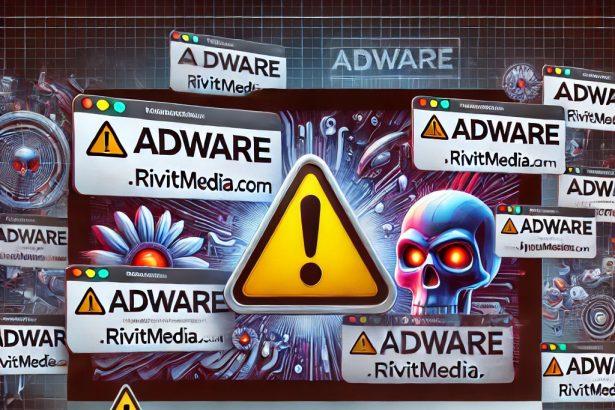Llowofthenamf[.]org is a rogue webpage that has gained notoriety among cybersecurity researchers for its deceptive tactics and potential to expose users to harmful online content. Discovered during routine monitoring of suspicious websites, llowofthenamf[.]org lures unsuspecting users with a fake CAPTCHA prompt and attempts to gain permission to send browser notifications. These notifications can lead to intrusive ads, scams, and even malware infections. This article delves into how this threat operates, the risks it poses, and how to recognize it if your device is affected.
llowofthenamf[.]org Threat Overview
| Threat Attribute | Details |
|---|---|
| Name | Ads by llowofthenamf[.]org |
| Threat Type | Push Notification Ads, Pop-up Ads, Browser Spam |
| Detection Names | Fortinet (Phishing), Seclookup (Malicious), ESET (Suspicious), others |
| Associated Email | N/A |
| Serving IP Address | 34.195.224.242 |
| Observed Subdomains | ldojo.llowofthenamf[.]org, 2oq2h.llowofthenamf[.]org, etc. |
| Symptoms of Infection | Pop-up ads, push notifications from unknown sources, slow browsing speed |
| Distribution Methods | Rogue ad networks, deceptive pop-ups, potentially unwanted applications |
| Damage Potential | Privacy issues, system slowdown, potential malware infections, scams |
| Danger Level | High |
What is llowofthenamf[.]org?
At first glance, llowofthenamf[.]org appears harmless. It displays a seemingly innocent message, telling visitors to click “Allow” to verify they are not robots. However, this is a deceptive prompt — not a legitimate CAPTCHA. Once a user grants permission, the site starts sending persistent browser notifications, many of which promote dubious or malicious content. These may include fake software updates, tech support scams, adult content, or links to malware-laden websites.
The site doesn’t operate alone; it often redirects users to other equally hazardous domains. These redirections and pop-ups are usually triggered through rogue advertising networks or potentially unwanted applications (PUAs) installed on the user’s system.
Why It’s Dangerous
Allowing llowofthenamf[.]org to send notifications means handing control over a part of your browser to a malicious actor. These ads are not just annoying — they often link to phishing pages, fake antivirus tools, or other malware installers. Worse still, these messages can appear persistently, even when you’re not browsing the web.
Another concerning aspect is the site’s use of IP-based targeting. Depending on your geolocation, you might see slightly different scams or malicious offers. This variability helps the operators evade detection and makes the threat more difficult to contain.
Manual Adware Removal Process (Windows & Mac)
Step 1: Identify and Uninstall Suspicious Applications
For Windows Users
- Open Task Manager by pressing
Ctrl + Shift + Esc. - Navigate to the “Processes” tab and search for unknown or high-resource-consuming processes.
- If you detect anything suspicious, right-click and select “End Task.”
- Go to
Control Panel>Programs>Programs and Features. - Locate and uninstall any unfamiliar programs.
For Mac Users
- Open
Finderand click onApplications. - Identify and move any suspicious applications to the
Trash. - Empty the
Trash. - Check
System Preferences>Users & Groups>Login Itemsfor unknown startup programs and remove them.
Step 2: Remove Malicious Browser Extensions
Google Chrome
- Open Chrome, click
Menu(three dots) >Extensions. - Locate and remove unknown extensions.
- Reset Chrome:
Settings>Reset settings> “Restore settings to their original defaults.”
Mozilla Firefox
- Click
Menu>Add-ons and themes. - Remove suspicious extensions.
- Reset Firefox:
Help>More troubleshooting information> “Refresh Firefox.”
Safari (Mac)
- Open Safari, go to
Preferences>Extensions. - Delete unknown extensions.
- Reset Safari:
History> “Clear History.”
Microsoft Edge
- Click
Menu>Extensions. - Remove any unfamiliar extensions.
- Reset Edge:
Settings>Reset settings> “Restore settings to their default values.”
Step 3: Delete Adware-Associated Files and Folders
For Windows Users
- Press
Win + R, type%AppData%, and press Enter. - Locate and delete suspicious folders.
- Repeat for
%LocalAppData%,%ProgramData%, and%Temp%.
For Mac Users
- Open Finder and press
Shift + Command + G, then enter~/Library/Application Support/. - Remove any suspicious folders.
- Repeat for
~/Library/LaunchAgents/,~/Library/LaunchDaemons/, and~/Library/Preferences/.
Step 4: Flush DNS Cache to Remove Adware Traces
For Windows Users
- Open
Command Promptas Administrator. - Type
ipconfig /flushdnsand press Enter.
For Mac Users
- Open
Terminal. - Enter
sudo killall -HUP mDNSResponderand press Enter.
Step 5: Restart Your System
Perform a reboot to apply the changes and ensure the removal process is complete.
Automatic Adware Removal Using SpyHunter (Windows & Mac)
For an effortless and effective solution, use SpyHunter, a powerful anti-malware tool designed to detect and remove adware completely.
Step 1: Download SpyHunter
Click the link to download SpyHunter: Download SpyHunter Here.
Step 2: Install SpyHunter
Follow the installation guide based on your operating system:
For Windows Users
- Run the downloaded
.exefile. - Follow the installation instructions.
- Launch SpyHunter and allow it to update its malware database.
For Mac Users
- Open the downloaded
.dmgfile. - Drag and drop SpyHunter into
Applications. - Open SpyHunter and let it update its database.
Step 3: Scan and Remove Adware
- Open SpyHunter.
- Click
Start Scan. - Wait for the scan to complete.
- Click
Fix Threatsto remove detected malware.
Step 4: Restart Your Computer
After SpyHunter removes all threats, restart your system to ensure all adware components are fully removed.
Conclusion
Llowofthenamf[.]org is more than just a nuisance — it’s a serious threat to your privacy and cybersecurity. By disguising itself behind a fake CAPTCHA and tricking users into enabling browser notifications, it opens the floodgates for unwanted and potentially dangerous content. If you notice sudden pop-ups or ads that seem unrelated to your browsing habits, you might have interacted with llowofthenamf[.]org or a similar malicious site.
While we have not included a removal guide here, immediate action is recommended. Closing the browser window is not enough — the notification permissions must be manually revoked, and your device scanned for malware.




